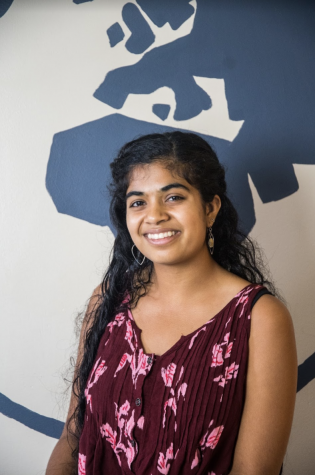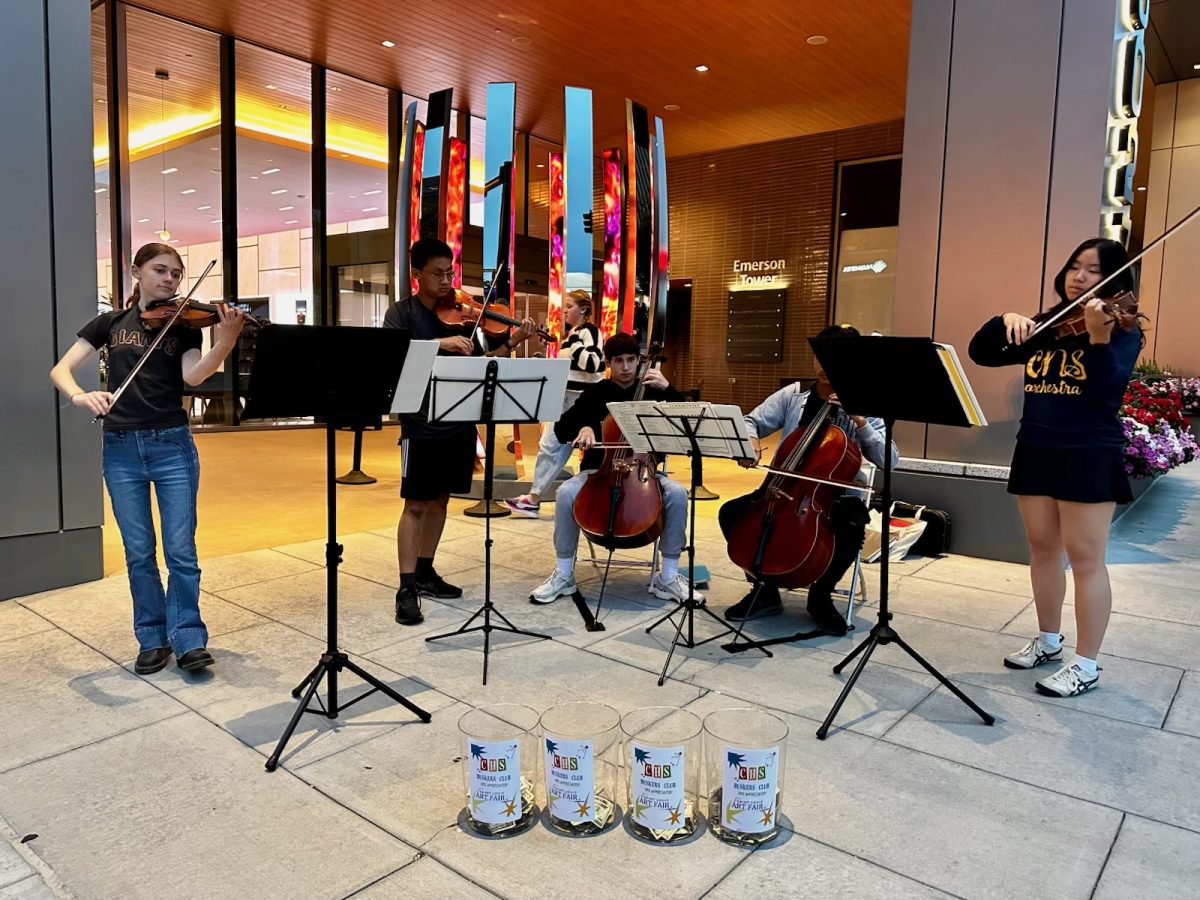The Core Issue
May 8, 2015
As Wydown Middle School theater students headed home from rehearsal on Jan. 28, the Board of Education was preparing to meet for a final discussion regarding the Middle School Program Review.
That night, the Board made a decision about the middle school’s schedule, a decision which communicates what they believe will continue to make Wydown one of the best middle schools in the country. However, their decision also reflects a small shift in values, which is what is most concerning to those hesitant about the Board’s decision.
Next year, the schedule at Wydown Middle School will look a little different. Although still in the early stages of development, according to Assistant Superintendent of Teaching and Learning Milena Garganigo, in the proposed schedule for next year, the school day will be 16 minutes longer. Each of students’ three elective classes will meet for 40 minutes each day. Students will attend math and science classes every day for 67 minutes, while literacy and social studies courses will continue to have 93 minutes every other day.
The discussion concerning these changes offers an interesting insight into a national conversation: the importance of core versus non-core curriculum.
After two years of frequent conversations, the Middle School Program Review came to an end on Jan. 28. The Board made four official recommendations to Wydown Middle School, calling for an increase in instructional time for core classes, a push for effective use of instructional time and additional interventions for students who need further help or resources.
Reaching a decision was no easy feat. Following heated conversation, the Board eventually came to a 4-3 vote approving the study. While some heralded the action as a positive move, others in the Clayton community questioned the reasoning behind the study and the proposed changes.
The review sprouted from an ongoing Clayton financial study which showed comparisons of the middle school’s core instructional time to that of other schools in the area and nationally.
One of the Board’s primary jobs is to critique the District’s schools, and in 2013 Wydown was next in line for a formal study. As the review progressed; the Board became increasingly concerned about the rigor of the middle school’s core curriculum, specifically in both math and science.
Student feedback suggested that many ninth graders felt unprepared for the increase in workload at CHS. Along with that, Wydown’s adoption of a new math curriculum, Singapore Math, did not naturally fit into the current block schedule.
“The high school was having to keep taking over some of the curriculum that really the middle school was responsible for because of time crunches,” Garganigo, one of the three central office administrators involved in the review, said.
Currently, Wydown runs on a block schedule, on which students meet in their core classes (math, science, literacy and social studies) every other day for a 90-minute period. Elective courses (foreign language, gym, performing arts and visual arts) meet every day for 45 minutes. With the block schedule, math teachers are currently teaching Singapore lessons designed for 60-minute classes within a 90-minute time frame.
“When the Board first came up with the goals, the idea was to make it a broad direction so that the middle school could take ownership of it, and really identify what they thought were their strengths and weaknesses and self-evaluate,” School Board Vice President Kristin Redington said. “Yet the Board had a theme of concern about the core curriculum, because the core curriculum can be measured.”
These core measurements come predominantly from MAP tests, a Missouri standardized test taken by students each year starting in third grade. The MAP test focuses solely on core subjects. The concern was that, within the District, students’ scores stopped increasing in middle school, while they continue on an upward trend in both elementary and high school.
Although this acceleration fits into a nationwide trend, often referred to as “the middle school dip,” it did cause the Board to evaluate the rigor of the middle school’s core classes.
“[The test scores] don’t stand on their own, but it was enough to raise the Board’s concern and give a focus to the study to ensure that we were appropriately delivering the core curriculum to our students,” Susan Buse, president of the BOE, said.
With a new focus, the study progressed. Small selections of teachers were asked about time needs to effectively deliver their curriculum, parents and students were involved in study committees and administrators, including Principal Mary Ann Goldberg, were responsible for bringing the final decision into action.
According to Goldberg, during the process, there were opportunities for all teachers to provide their input and their reactions to the work of the committee.
After one year, when most studies would have come to a close, a decision within the Board seemed unlikely. With the dissent around the middle school review, the BOE voted to extend the project. In the end, a year and a half later, a 4-3 vote in the Board resulted in approval of an increase in the number of core minutes at the middle school each day in hopes of facilitating a more rigorous core learning environment.
Buse, who voted for the increase, believed that the Board’s decision seemed necessary for this rigor.
“The two have to come together and there has to be a balance of the two: a strong core curriculum in a rich environment,” she said.
However, Redington voted against the study. She was concerned with the impact that it might have on electives and the need for a more articulated reason for the increase instead of committing first to 45 minutes of daily math, along with allowing recent changes in curriculum and instruction to matriculate. She was also concerned about the possibility of unforeseen consequences.
“A world-class education demands consistent reiterations to better a system, but the unknown, that makes me a little nervous because we don’t know what the unintended consequences of it will be,” she said.
Now, with a draft of the new schedule developed and announced by the Wydown administrative team, the implications are more evident. Goldberg, who oversaw the making of the proposed schedule, says the new schedule is trying to take both sides into perspective.
“I think people don’t like change,” Goldberg said. “I think change is hard for some people. Change is not hard for me. I think some people think that this is us throwing everything out. But this is not a drastic change. I think they will be surprised. I’m hoping that they’re happy with it and see that we have honored everything they thought was important.”
After receiving the recommendations at a staff meeting, many teachers expressed concern with what the study would mean for the future of the middle school, paying special attention to the proposed increase in core minutes. For elective teachers, the possibility of losing class time posed considerable concern.
Stephanie Roberson, the English language learners teacher at WMS, works with international students. To students working on mastering English, electives often offer a welcomed break from language-heavy and content-based core classes.
“Sometimes it’s in chorus, when you are singing the same songs as everybody else is singing, where there’s lots of repetition and everybody understands the melody, where a kid that is coming from China actually feels like they can keep up,” Roberson said.
Students for whom language is not a barrier also benefit immensely from non-core classes. Band Director and District Fine Arts Coordinator Paul Varley believes that elective courses add a layer of depth to middle school students’ academic experience.
“Electives are what make us who we are,” he said.
Clayton traditionally supports elective development heavily, and with ample resources, the schools offer many remarkable non-core programs.
“One of the things that makes Clayton, Clayton is that they value the arts so much,” Varley said. “I’m not sure that they want all their kids to go into it for a living, but they value it. They want their kids to have an experience like that, otherwise why would they have built this auditorium?”
The new middle school building, fully finished in 2015, is equipped with a state-of-the-art auditorium, capable of holding professional-level productions.
Wydown, a school that prides itself on the development of the “whole child,” intends for students to grow academically, socially and emotionally. The elective classes, including an extensive theater arts program, the choice of four languages, a wide array of arts classes and daily physical education courses, focus on the development of the child that isn’t purely academic.
“It really goes back to that ‘whole child’ piece, that we’re not just a core curriculum district, and that we really need, especially in middle school, for kids to have opportunities to explore different options that they may not know yet that they’re interested in,” Garganigo said.
Garganigo believes that this commitment to the “whole child” is maintained in the new schedule.
However, some teachers at WMS are not so sure that this commitment will be maintained. Additionally, many core teachers also feel uncomfortable with an increase in core minutes.
Wydown has a “team” system, which pairs 80 students with their four core teachers for the entire year. The program allows teachers to develop more meaningful relationships with their students and also provides the four teachers with an environment in which to collaborate and communicate.
WMS science teacher Josh Wilmsmeyer pointed out the possible consequences of increasing core time with regard to the team system.
“What makes teams effective in middle school is heavily reliant on common planning time amongst teachers,” he said. “An increase in teaching minutes decreases planning time.”
As of now, the proposed schedule lengthens the school day by 16 minutes. Therefore, planning times should remain relatively unchanged. However, all four core classes will no longer be aligned.
Roberson is also worried about what effect an increase in core instructional time could have on struggling students, but acknowledged the difficult task administrators took on in developing a schedule with so many stakeholders.
“If we are talking about planning interventions for kids who are struggling or for international students, modifying assignments and assessments for kids who need it, or modifying for kids that need extension work, that takes time,” she said.
Along with uneasiness over the impact of the recommendations, many teachers also expressed concern with the process of the study itself.
The committee had a host of Wydown teachers, but many around the building were confused about the nature of the study. By design, the review was meant to be open-ended; however, this idea sometimes led to participants questioning the purpose of the study.
Wilmsmeyer, who served on the official Middle School Program Review Committee and also on an early self-study committee launched before the Board directed review, wondered whether all of the necessary information was communicated to all of the stakeholders.
“My worry, though, is that the data from those meetings [data from focus groups done at WMS as part of the review] was never actually shared out,” Wilmsmeyer said. “Pieces were presented at times, but we never got the full summary.”
Shortly after the Board released the final report, teachers around the building rallied together to express their uncertainties with the recent announcement.
The day after a school-wide faculty meeting, a letter voicing the concerns of the teachers began circulating through the school. The letter was addressed and promptly delivered to the Board at a meeting. It is brief and to the point, stating that, “the report never names a problem. If we know the problem, we will work to change it. At this point, that problem is not clearly identified.”
The letter, signed by approximately 50 teachers from both core and non-core subjects, goes on to express future concerns resulting from the review.
“This report does not represent a consensus of our faculty. We worry about the rapid pace of change without the opportunity to explore the intended and unintended consequences of these changes.”
The letter points out the rich opportunities students have at the middle school to explore new topics, and voices concern as to whether the change proposed in the review was conducted with a clear question in mind.
“When we make change, let’s have it be deliberate change with clearly defined objectives and goals.”
The lack of such “clearly defined objectives” was one of the greatest sources of concern.
Although some are uncomfortable with the proposed scheduling changes, Wydown, as a school, serves as an outlier when compared to many other middle schools. Currently, the WMS schedule offers a 50/50 split between core and elective time, which means that students spend half of their day engaged in non-core activities.
Most schools in the nation have a split that is far more favorable to core classes, and, in the committee’s deliberations over improvements for the middle school, this fact was a recurring piece of evidence of the need for increased core time.
However, many teachers and administrators believe that Clayton, as a top-performing district, should not necessarily be taking cues from neighboring schools.
“Someone said at a meeting, ‘98 percent of other schools don’t have three electives,’ and I said, ‘You know what, if our scores were worse than 98 percent of the other schools then I’d agree with you, but you know what, our scores are really good, they’re really high,” Goldberg said.
As of next year, all students will still be enrolled in three elective classes. Additionally, the District administration announced, at an all-school meeting concerning the new schedule, that no staffing changes for the upcoming school year will be made.
The conversation about core curriculum exists well outside the realm of the Clayton School District. In fact, as national pressures to perform in predominantly core areas, especially science and math, rise, core curriculum stands as one of the most debated issues across educational battlelines.
The contention around Wydown’s new schedule serves as merely one example of this national conversation.
One of the most frequent debates surrounding this issue concerns the Common Core Standards, a nation-wide set of regulations that outlines specific academic requirements across all grade levels.
The Missouri Common Core is in the process of an internal review, in which the committee hopes to individualize the standards at a state level.
Professor James Shuls, a member of the Missouri Common Core Committee and an assistant professor of educational leadership and policy studies at the University of Missouri-St. Louis, explained the immense impact of national standards, such as the Common Core.
“Tests impact accreditation scores, and impact teacher licensing programs, and teacher training programs … we could say they’re just standards, but they impact nearly every aspect of our educational system,” Shuls said.
The Common Core curriculum outlines the basic learning objectives for every grade level. For example, as dictated by the Common Core, any fourth grade student should be able to use all four mathematical operations to solve problems. According to Shuls, teachers can interpret the standards to fit their own lessons.
Although concerned about the nature of these regulations, Shuls still adamantly believes in the practice of set curricula. However, he worries about the practicality of national standards.
“The standards are important, and every school should have standards, but I think we gain very little from having one set of national standards,” he said.
Despite the necessity for standards, the Common Core puts many schools in a tough spot, especially specialty schools which focus specifically on STEM or even arts education. Often, these schools still must comply to nationally-regulated curriculum goals, which are not designed with any speciality in mind.
There is a degree of autonomy that schools lose when forced to adopt the nation-wide Common Core.
“When a state adopts standards, what we’re doing is saying what we value, and saying what’s important, and saying what teachers should teach,” Shuls said. “And what I value may not be the same as what you value, and what I think is important may not be the same as what you think is important.”
Shuls even believes that forcing schools to comply to state-mandated standards is too restrictive. Ideally, he sees individual districts having the opportunity to choose from an assortment of standards, catered to specific needs or academic focuses.
“The uniformity of everyone doing the same thing is not important,” he said. “I think we gain very little from that, but we gain from experimentation, people doing different things, doing this sort of laboratory of experimentation, [where] we’re trying different things, we’re figuring out what works, and local communities are more invested in the decisions of their school because they actually have some say in the matter.”
With such an emphasis on the Common Core, non-core curriculum has a harder time receiving national attention.
“We give less money to these programs, we give less time to them,” Shuls said. “I simply think they’re not as strong as a lot of people would like them to be, again, probably because of the incentives system we created.”
This “incentive system” on which the United States’ has based its entire system of education, is based off of a slew of standardized tests.
James Croft, a doctoral student at the Harvard Graduate School of Education, believes that these standardized tests are not representative of student comprehension. The majority of these tests are a barrage of multiple choice questions, which Croft sees as thin intellectual investigations into core content areas. However, Croft does not believe that the nation’s testing practices will change any time soon.
“We are terrified of what we will find out, which is that most of our students are much less educated than we even think now,” Croft said.
Despite his hesitancy with trusting national standardized tests, Croft still sees core subjects as tenets of one’s educational development. Nevertheless, he believes that how schools design their curriculum might not always be in the best interest of student engagement or academic growth.
“Traditional core subject disciplines are very important, but not often in the way that they are approached,” Croft said. “What is important about them is the mode of thinking that they represent. You should be leaving school being able to think like a historian, think like a mathematician, think like an artist, right for when that is valuable to you. That is different from knowing everything that happened date by date from 1550 to 2014.”
Additionally, Howard Gardner, renowned educational figure at the Harvard Graduate School of Education, believes that the lines should be blurred between core and non-core.
“I’d like to eliminate the distinction between ‘core’ and ‘non-core.’ I think that children should be exposed to the range of art forms at an early age,” Gardner said. “And then have the chance to pursue at least one art form as seriously as they pursue the so-called ‘core’ subjects.”
Across the country, schools try to give students ownership over their own education in a variety of ways. Walter Payton College Preparatory High School, often considered the top-performing public school in Chicago, Illinois, has a unique seminar program, which allows students to partake in two non-traditional classes for an hour and a half every other week, along with additional normally-scheduled elective classes.
Many of the seminar programs are focused on topics even beyond traditional non-core subjects, including knitting, yoga, Taekwondo, jazz dance and more academic courses, like the history of the supreme court justices.
Every other Wednesday, math teacher Benjamin Walker spends an hour and a half with 18 other students in his seminar class, “Climb On.” Led by him and a team of two students, this seminar covers the fundamentals of rock climbing.
“Last week, we talked about the myth of the top and … going beyond this idea of ‘I want to get to the top,’ and more about, ‘What is the best way that I can push myself as a climber?’”
The seminar classes offer a well deserved break from the academic grind of Payton, and allow teachers to focus on the school’s four main themes: compassion, character, courage and curiosity.
“I get to be that person that is concerned less about student understanding concept goals and concerned more about how they are developing their character or ethical goals and how they are contributing to a community,” Walker said.
Similar to Clayton, Walter Payton has a diverse socio-economic body of students, ranging from families of millionaires to students that live below the poverty line. The affluence of some families gives the seminar program ample resources. However, Walker was quick to point out an abundance of money is not what drives Payton’s commitment to the program.
“This is who we are at Payton,” he said. “And do you fit into the ideological, pedagogical goals and, if so, how? It is not only supported, but it is part of the job.”
The goal of the seminar program permeates past any Common Core standard.
“The experiences are meant to inspire and generate curiosity and give students additional communities to be a part of and contribute to and grow from,” Walker said.
Building this sense of community can come easily within the structure of any elective class, even in more traditional environments than the seminar program. At most schools, like Wydown, students have the opportunity to choose their elective courses, which are often catered to individual interests. Croft believes that a sense of ownership can have dramatic effects on students’ experience.
“So many of people’s educational and life experiences are intellectually disempowering because you are told what to think about and in what order and how to do it,” Croft said. “You can actually create a lot of intellectual dependence that way.”
Croft believes that elective classes can allow many students to free themselves from this dependency.
“I think for many young people in school, their experience is that they find most life and richness in the educational system in those electives because they get to determine it,” Croft said.
The United States’ commitment to education is an immense undertaking. As Croft pointed out, public education is one of the few things for which the U.S. Government takes full responsibility. Croft believes that U.S. education is bogged down under standards and requirements, amidst heated debates between the importance of core and non-core curriculum. Croft believes that the primary goal of a national education is to inspire and empower the youth of the nation.
“The more we can give people, progressively, the capability to step back from the environment they are in – to examine it critically, to take up different pieces and look at them from different angles, and pull them apart and put them back together … we are making them into powerful human beings who have control over their destiny,” Croft said. “Schools could do that in a way that no other social institution can.”
Tethered to Common Core Standards, schools don’t always have the ability to carry out their unique visions. Sometimes even forces outside of an educational lense can permeate into a student’s schedule.
The U.S. has a history of melding its educational system to political imperatives. When Sputnik launched in 1957, America had what Croft referred to as a “national identity crisis.” Across the country, schools funneled money into math and science education.
“Why are we setting our national priorities of the education of our young people, that is going to determine a significant amount of their lives, on some satellite being launched in Russia?” Croft said.
Even at WMS, teachers see the impact of this national focus on science and math. Although the U.S. is no longer on a race to the moon, recent national test scores show that the nation is beginning to lag behind other countries.
“It’s almost like Sputnik all over again, but it’s not like there’s a Sputnik. Now it’s everybody else’s scores,” Varley said.
However, Clayton remains engaged and opinionated in this national conversation. District administrators hold frequent discussions about the role of core curriculum.
“We’re constantly in conversation about how to maintain an overall rich curriculum that has both components of the core and the non-core,” Garganigo said.
And the Program Review was in no way an end to this conversation. In the final pages of the review, Board members said that the study was merely a starting point for a larger conversation.
“This report represents much more of a beginning point for the work at Wydown Middle School as opposed to an ending point.”
WMS teachers hope that all community members will be made aware and invited to engage in future conversations. In fact, the review may bring about more questions than it initially posed.
“Maybe, as a community, we can come together and say ‘Are we asking ourselves the right questions?’” Roberson said. “If we are thinking about growing, are we really growing in the right direction? Or are we grafting roots onto our roots that don’t fit? Are there other questions that we could be asking?” ⎫






![“[The] biggest obstacle right now is getting up early. I'm still getting back into the school mode, and usually I'm the type of person who wakes up a minute before my alarm. But right now, that is definitely not happening.” -Anna Hormberg, History teacher](https://www.chsglobe.com/wp-content/uploads/2025/09/image3-2-1200x900.jpg)



![“I love working with students, that's why I decided on being a high school teacher. I was going to go the University route, but it's a different feel[ing]. Working with students is what makes it fun, keeps it alive, keeps me, trying to connect with students about my passion with ancient Rome and Greece and how they overlap, and how the stuff we do in class impacts their lives. That's kind of the goal I have, is having them see themselves, students in this larger scope of history from 2000 years ago, and how you're part of that now. ”
- Matthew Crutchfield, CHS Latin teacher](https://www.chsglobe.com/wp-content/uploads/2025/09/image2-3-e1757531718144-1200x872.jpg)
!["It's really hard to make friends in Clayton high school if you're a newcomer. Everybody already knows each other, and they have established friendships for many years. My goal is always to make my space a safe one for them to take risks, [and] relax." Nancy Gamble, English Language Specialist](https://www.chsglobe.com/wp-content/uploads/2025/09/image1-e1757625469759-1200x843.png)
